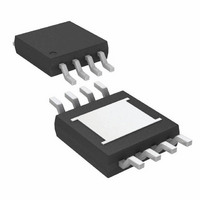LT3085MPMS8E#TRPBF Linear Technology, LT3085MPMS8E#TRPBF Datasheet - Page 13

LT3085MPMS8E#TRPBF
Manufacturer Part Number
LT3085MPMS8E#TRPBF
Description
IC LDO REG ADJ 500MA 8-MSOP
Manufacturer
Linear Technology
Datasheet
1.LT3085EDCBTRMPBF.pdf
(28 pages)
Specifications of LT3085MPMS8E#TRPBF
Regulator Topology
Positive Adjustable
Voltage - Output
Adjustable
Voltage - Input
1.2 ~ 36 V
Voltage - Dropout (typical)
1.35V @ 500mA
Number Of Regulators
1
Current - Output
500mA
Current - Limit (min)
500mA
Operating Temperature
-55°C ~ 125°C
Mounting Type
Surface Mount
Package / Case
8-MSOP Exposed Pad, 8-HMSOP, 8-eMSOP
Lead Free Status / RoHS Status
Lead free / RoHS Compliant
Available stocks
Company
Part Number
Manufacturer
Quantity
Price
APPLICATIONS INFORMATION
between the devices is within 2°C, showing excellent
tracking between the devices. The board temperature has
reached approximately 40°C within about 0.75 inches of
each device.
While 90°C is an acceptable operating temperature for these
devices, this is in 25°C ambient. For higher ambients, the
temperature must be controlled to prevent device tempera-
ture from exceeding 125°C. A 3-meter-per-second airfl ow
across the devices will decrease the device temperature
about 20°C providing a margin for higher operating ambi-
ent temperatures.
Both at low power and relatively high power levels de-
vices can be paralleled for higher output current. Current
sharing and thermal sharing is excellent, showing that
acceptable operation can be had while keeping the peak
temperatures below excessive operating temperatures on
a board. This technique allows higher operating current
linear regulation to be used in systems where it could
never be used before.
Quieting the Noise
The LT3085 offers numerous advantages when it comes
to dealing with noise. There are several sources of noise
in a linear regulator. The most critical noise source for any
LDO is the reference; from there, the noise contribution
from the error amplifi er must be considered, and the gain
created by using a resistor divider cannot be forgotten.
Traditional low noise regulators bring the voltage refer-
ence out to an external pin (usually through a large value
resistor) to allow for bypassing and noise reduction of
reference noise. The LT3085 does not use a traditional
voltage reference like other linear regulators, but instead
uses a reference current. That current operates with typi-
cal noise current levels of 2.3pA/√Hz (0.7nA
10Hz to 100kHz bandwidth). The voltage noise of this is
equal to the noise current multiplied by the resistor value.
The resistor generates spot noise equal to√4kTR (k =
Boltzmann’s constant, 1.38 • 10
temperature) which is RMS summed with the reference
current noise. To lower reference noise, the voltage set-
ting resistor may be bypassed with a capacitor, though
this causes start-up time to increase as a factor of the RC
time constant.
-23
J/°K, and T is absolute
RMS
over the
The LT3085 uses a unity-gain follower from the SET pin
to drive the output, and there is no requirement to use
a resistor to set the output voltage. Use a high accuracy
voltage reference placed at the SET pin to remove the er-
rors in output voltage due to reference current tolerance
and resistor tolerance. Active driving of the SET pin is
acceptable; the limitations are the creativity and ingenuity
of the circuit designer.
One problem that a normal linear regulator sees with refer-
ence voltage noise is that noise is gained up along with the
output when using a resistor divider to operate at levels
higher than the normal reference voltage. With the LT3085,
the unity-gain follower presents no gain whatsoever from
the SET pin to the output, so noise fi gures do not increase
accordingly. Error amplifi er noise is typically 100nV/√Hz
(33μV
another factor that is RMS summed in to give a fi nal noise
fi gure for the regulator.
Curves in the Typical Performance Characteristics show
noise spectral density and peak-to-peak noise character-
istics for both the reference current and error amplifi er
over the 10Hz to 100kHz bandwidth.
Overload Recovery
Like many IC power regulators, the LT3085 has safe operat-
ing area (SOA) protection. The SOA protection decreases
current limit as the input-to-output voltage increases and
keeps the power dissipation at safe levels for all values
of input-to-output voltage. The LT3085 provides some
output current at all values of input-to-output voltage up
to the device breakdown. See the Current Limit curve in
the Typical Performance Characteristics.
When power is fi rst turned on, the input voltage rises and
the output follows the input, allowing the regulator to start
into very heavy loads. During start-up, as the input voltage
is rising, the input-to-output voltage differential is small,
allowing the regulator to supply large output currents.
With a high input voltage, a problem can occur wherein
removal of an output short will not allow the output volt-
age to recover. Other regulators, such as the LT1085 and
LT1764A, also exhibit this phenomenon so it is not unique
to the LT3085.
RMS
over the 10Hz to 100kHz bandwidth); this is
LT3085
13
3085fb













